Private wells allow us to draw water directly from underground aquifers. While that’s a big selling point, well systems are also complicated — as useful as they are, they come with their own set of problems.
Low water pressure in a house that draws from a well is one common problem. What’s extra tricky is that unlike tap water, which is under the responsibility of municipal authorities and water suppliers, wells and their maintenance are the responsibility of the well owner. When there’s an issue with your well, you must figure out what’s wrong on your own and take appropriate action.
Fortunately, we’re here to guide you through the process. Based on our experience and research, we have identified the five most common reasons behind low well water pressure.
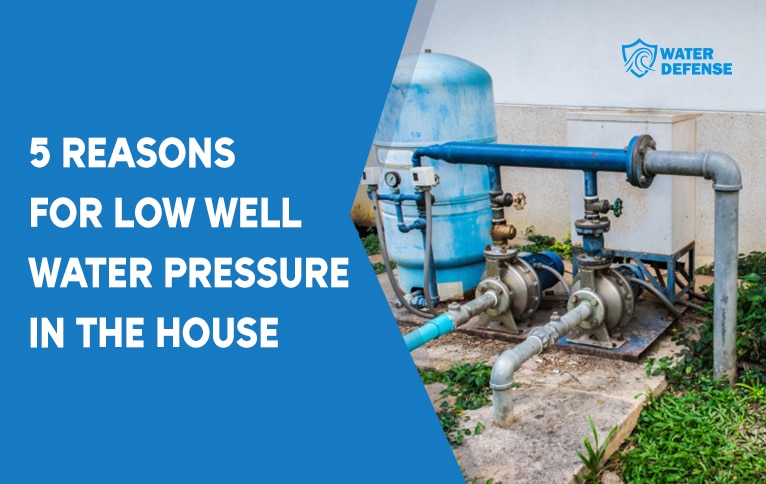
Some of the most common are clogged pipes, worn-down well components, and a drained aquifer. Keep reading to learn what else could create a low water pressure problem, and why and how deal with it.
How Does a Water Well Provide Water to a House?
Before we get to the meat of the matter, it’s good to recap how a private well works and go over the components it has.
A modern private well consists of the following:
- Well casing: The main body of a well that keeps external elements (such as soil and rocks) out of the system.
- Well lid: It protects the top of your well.
- Well pump: Using pressure, the well pump draws water from the underground aquifer.
- Water pressure tank: It collects the water drawn by the well pump. A well water pressure tank comes with pressure switches (30/50 or 40/60 psi) suitable for the water pressure needs of your household. This means that the pressure tank is responsible for water distribution.
- Filtration units (optional): Filtration units (sediment filters, whole-house filters, or water softeners) are optional. However, considering that well water tends to be full of sediment, most well owners install a filtration system. A water softener is another necessity considering the groundwater in the United States is usually hard.
Three of these components directly affect water flow: the well pump, water pressure tank, and filtration units. Any problem with these components can decrease the water pressure in your household.
How Can You Identify Low Water Pressure?
Low water pressure is not something you ignore, as it’s very noticeable:
- Appliances like dishwashers or washing machines take longer to get started and make gurgling noises.
- Water comes down from your faucets in a trickle.
- The pressure gauge shows that the pressure tank is operating below 40 psi (for 40/60 psi units).
Regularly monitoring the pressure gauge will allow you to identify problems leading to low water pressure before they cause a more severe problem. We recommend well owners to get into the habit of checking their pressure gauge weekly.
Once you’re sure you have a low water pressure problem, you can start looking for reasons and solutions.
5 Main Reasons for Low Well Water Pressure
Damaged or Malfunctioning Well Components
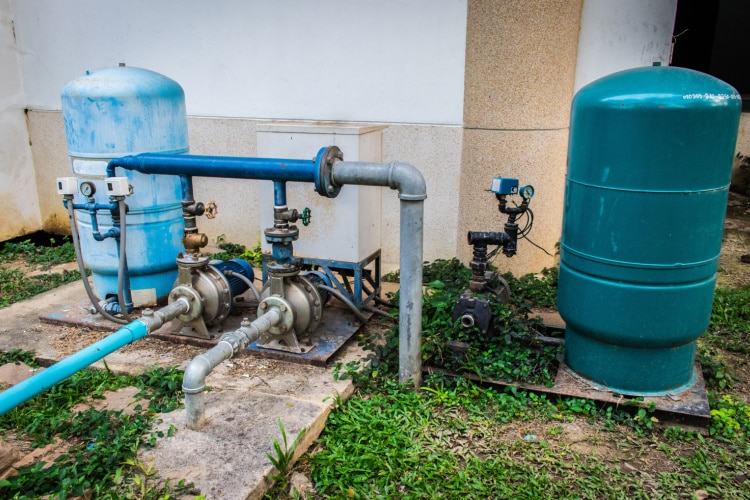
A well has two main parts directly affecting the water pressure: its well pump and water pressure tank. Damage to either will cause low water pressure.
If your well pump and water pressure are damaged, you need to call a professional plumber to assist you. They will inform you of the extent of the damage — if the damage is partial, you’ll only need to replace a component or, in the worst-case scenario, you’ll need to replace the whole pump or tank.
When you need to replace the whole tank, make sure you get the right size. We have a detailed guide on how to identify a waterlogged pressure tank and fix it which can help you with this.
Sometimes the problem can be small. For instance, you may get low water pressure from a waterlogged pressure tank or a maladjusted pressure switch setting. If the pressure switch setting is maladjusted, you can handle it on your own just by following our pressure switch adjustment guide.
Finally, it’s best to maintain your pressure tank on a regular basis to prevent problems with water pressure.
Clogged Pipes
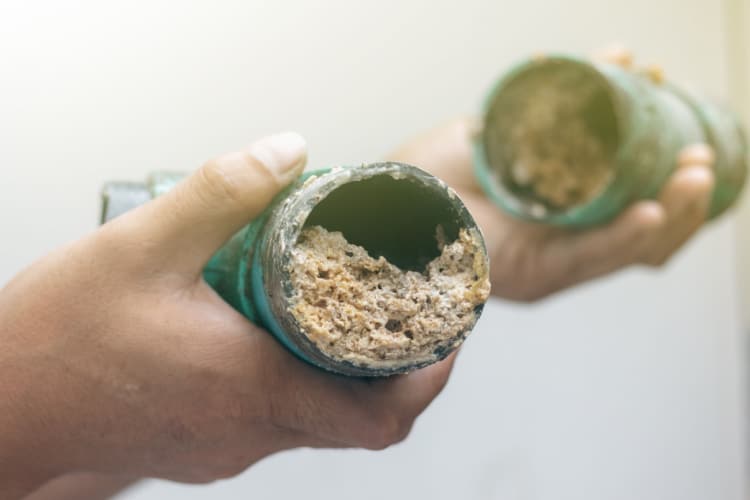
Most well setups have sediment filters that block sediment from entering the well casing. However, these filters aren’t as efficient as whole-house sediment filters, so sometimes sediment may build up inside the pipes and cause low water pressure at your faucets.
Additionally, well water is usually hard, meaning it has an abundance of calcium and magnesium molecules that stick to the surfaces they come into contact with. If you have hard water but no water softener, these minerals will eventually build up in your piping system, leading to low water pressure.
The solution to this problem is as follows:
- Turn off the water.
- Unscrew the pipes one by one with a wrench.
- Check the insides of the pipes with a flashlight.
- Scrub the insides of the pipes with a long and soft brush or a similar object.
- Screw the pipes back.
Although this is a relatively simple procedure, it’s also quite strenuous because it may take a whole day just to unscrew and re-screw all the pipes. So, you can always call a professional plumber to unclog and clean the pipes.
To prevent this issue from happening again, you should purchase an efficient sediment filter to prevent sediment buildup in the future. If you have hard water, consider installing a water-softening system.
Ill-Sized or Malfunctioning Filtration Unit
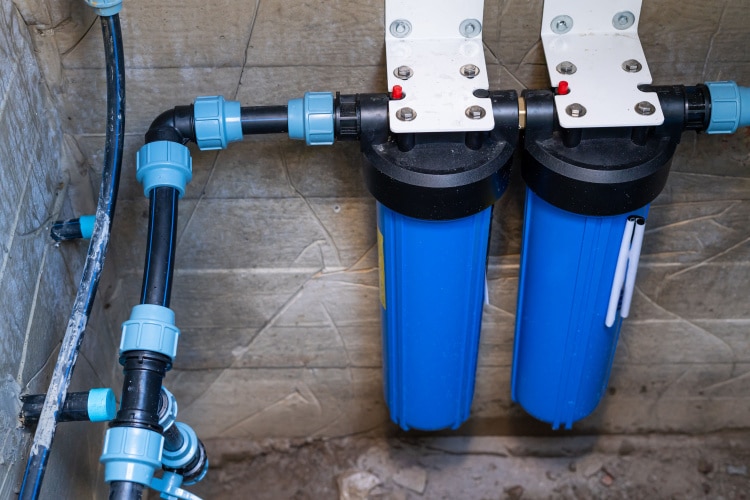
Well pumps draw and distribute water mainly at 20 GPM (gallons per minute). Whole-house filtration systems with the highest flow rate usually operate at 15 GPM, which is ideal for houses with up to seven bathrooms.
While that difference won’t cause a big problem in terms of water pressure at your faucets, a 7 GPM filtration unit in a 5-bathroom house will inevitably lower the water pressure. So, purchasing a filtration unit with a suitable flow rate for your home is essential.
But that’s not the only way a filtration unit can cause low water pressure.
Whole-house systems typically come with multiple filters. Depending on the model, they feature a sediment filter, an activated or catalytic carbon block, a reverse osmosis membrane, and a post-filter.
You need to replace these filters following the manufacturer’s instructions (typically, at least once a year). If you don’t, the contaminants build up on the filter screens, allowing less and less water to pass through and resulting in low water pressure.
Ill-Sized or Malfunctioning Water Softener
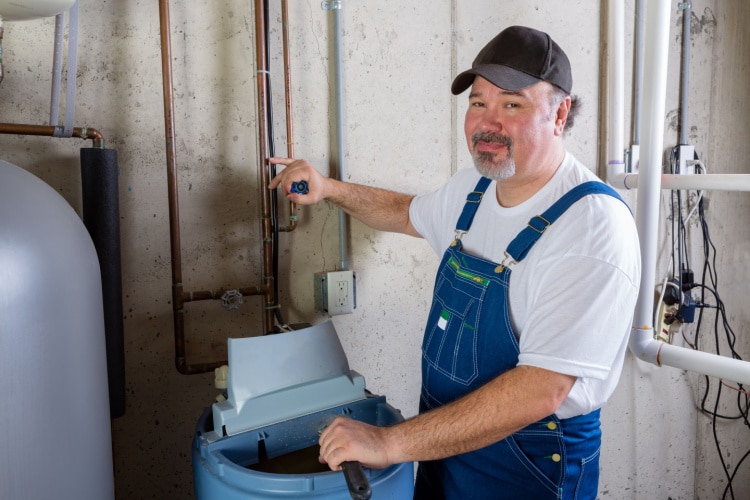
Water softeners come in grain sizes indicating how much water hardness they can handle. If your water’s hardness levels surpass the grain size of your water softener, the device will take longer to soften your water, causing a decrease in water pressure. So, it’s crucial to purchase a properly-sized water softener.
Additionally, water softeners are complicated systems with lots of lines and pipes. These machines also require regular and optimal backwash and regeneration cycles to operate effectively.
Due to mineral buildup in the resin, salt escaping from the brine tank, salt bridges, or resin beads escaping from the resin tank, the lines and pipes in a water softener can get clogged up. This will affect its efficiency, as it will lower the flow rate.
If you’re experiencing these issues, head out to our guide on why water softeners cause low water pressure. In that guide, we identify all the possible symptoms and offer solutions to each.
If the water softener is idle and not effective at doing its job, it will contribute to the mineral buildup in your piping system, which, in turn, will lead to more water pressure problems in the future.
The main takeaway is that it’s imperative to take great care to maintain your water-softening device if you want consistent water pressure.
Drained Aquifer
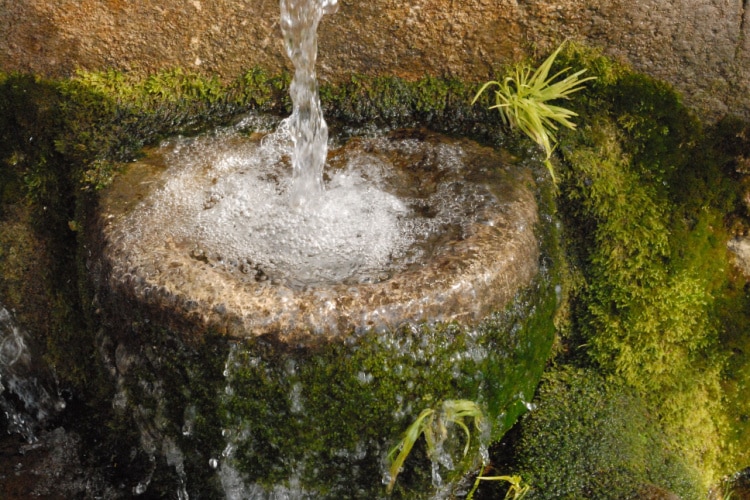
Aquifers are underground geological formations where water from the surface accumulates over millennia. However, that doesn’t mean that an aquifer will always have water. An aquifer can dry out as a result of drought or if too many wells are drawing water from it.
The first symptom of a drying aquifer is low water pressure. Then, the water will start to turn muddy because your well pump will draw less and less water. After a while, you won’t get water at all.
When an aquifer goes dry, you might expect it to recharge through the rainy season, but it’s not guaranteed.
So, either you’ll need to dig a well over a new underground water source or connect your house to the municipal water supply.
However, remember that this is a very rare scenario that shouldn’t be on your mind unless you’ve already eliminated all other possible causes.
Conclusion
Low water pressure at your faucets may be the result of a damaged well pump or water pressure tank. In such cases, call a plumber to confirm the cause and offer you a solution based on their findings.
Sometimes, sediment or minerals build up in the piping system of your house. If that’s the case, you can either inspect the pipes one by one by yourself or have a professional handle the job.
An ill-sized or malfunctioning whole-house water filter or softener will inevitably decrease the water pressure in your house. In such cases, installing a properly-sized device, replacing clogged filters, or cleaning the unit can solve the problem.
Lastly, on rare occasions, it’s possible that the reason behind your low water pressure is a drained aquifer. In such cases, you’ll need to find a new aquifer or apply to get reconnected to the municipal water lines.
.